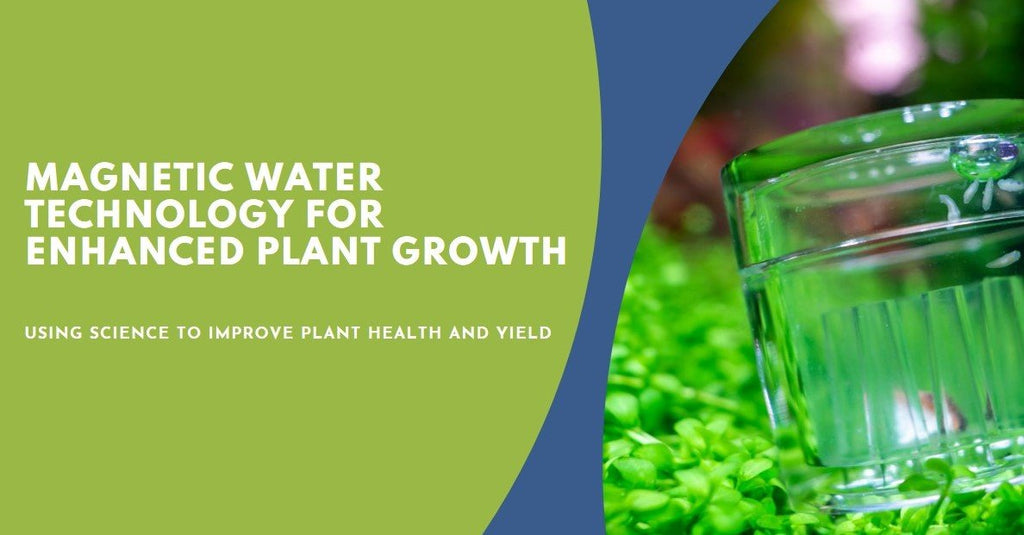The innovative use of magnetism to alter water properties for agricultural purposes has shown great promise in improving overall plant health, vigor, and crop yields. However, research indicates the ideal magnetic flux density applied to irrigation water varies depending on the specific plant species. This article will provide science-backed recommendations for customizing magnetic water treatment methods to achieve optimal results for vegetables, fruits, herbs, houseplants, and other crops.
💦 Magnetized Water Benefits for Plants
Treating water with magnetic fields before using it for irrigation has been demonstrated to enhance seed germination, plant growth, flowering, fruit production, and other key plant processes. But how does it work exactly? When water molecules pass through a magnetic field, the polarity of the hydrogen atoms is altered. This disrupts the hydrogen bonding between water molecules, reducing surface tension and creating smaller water clusters that move more freely within plant tissues.
Scientists have confirmed magnetized water enhances hydration, nutrient absorption, photosynthesis, and enzymatic activity in plants through several physiological mechanisms:
- Increased soluble oxygen and mineral transportation throughout the plant due to lower surface tension and smaller water clusters.
- Improved permeability of root and leaf cell membranes allowing better water and nutrient uptake.
- Stimulation of energy metabolism, ATP production, and growth hormone activity.
- Regulation of stress ethylene levels and antioxidant activity, reducing oxidative damage.
With so many potential benefits, it’s no wonder that treating irrigation water with magnetic fields has been embraced by commercial greenhouse growers, hydroponic farms, and even home gardeners. But the key is tuning the strength of the magnetism to best meet the needs of each plant species and cultivation environment.
🌿 Tailoring Magnetic Flux Density to Plant Types
The intensity of a magnetic field is measured in gauss units, indicating the magnetic flux density. Studies show that plants respond optimally to different gauss levels based on factors like:
- Size and structure of the root system.
- Transpiration rates.
- Preferred soil moisture levels.
- Sensitivity to salts and osmotic stress.
For example, plants with finer feeder roots or lower transpiration such as tomatoes, peppers, and lettuce thrive at lower magnetic flux densities between 100-300 gauss. But plants with thicker roots and higher water demands like corn, potatoes, and wheat require stronger magnetic fields from 300-500 gauss.
Here are some general guidelines for pairing magnetic water systems with different plant categories:
Vegetables
- Leafy greens (lettuce, spinach): 100-150 gauss
- Brassicas (broccoli, kale): 150-200 gauss
- Roots (carrots, radishes): 200-300 gauss
- Vining crops (cucumbers, peas): 250-350 gauss
- Nightshades (tomatoes, peppers): 100-250 gauss
- Alliums (onions, garlic): 150-250 gauss
Fruits
- Citrus (lemons, limes): 150-250 gauss
- Vine fruits (melons, squash): 300-400 gauss
- Solanaceous (tomatoes, eggplant): 100-250 gauss
- Brambles (raspberries, blackberries): 200-300 gauss
- Tree fruits (apples, cherries): 250-350 gauss
Herbs
- Delicate leafy herbs (basil, parsley): 100-150 gauss
- Heartier herbs (thyme, rosemary): 150-250 gauss
- Roots (ginger, turmeric): 200-300 gauss
Houseplants
- Succulents: 100-150 gauss
- Orchids: 150-200 gauss
- Tropicals: 200-250 gauss
- Cacti: 100-200 gauss
Outdoor plants can utilize higher gauss levels, while indoor houseplants and greens prefer gentler magnetic flux density. It’s also key to control water alkalinity, pH, oxygenation, and mineral levels to complement magnetic water treatment.
🧑🔧 Choosing the Right Magnetic Water Technology
A range of magnetic water treatment devices are available to home gardeners and large-scale agricultural operations alike. The optimal type and strength depends on factors like water alkalinity, application method, and crop selection.
Permanent magnets are simple and inexpensive but produce a fixed gauss level. Electromagnetic coils allow adjustable field strength but require electricity and proper wiring. Electrolytic systems combine magnets with electrodes that alter water conductivity.
Small greenhouse growers can find portable, plug-and-play magnetic water systems from around $300 to $2000 depending on capacity. Larger commercial farms may need heavy-duty electrolytic or electric coil units running from $2000 up to $10,000 for high volumes of water. This investment can pay off in the form of increased yields and plant quality.
🔩 Optimizing Magnetic Water Treatment for Any Plant
While more research is still needed, it's clear that properly calibrated magnetic water technology has the potential to significantly improve agriculture sustainability, from the backyard gardener to large-scale farming. Matching the optimal magnetic flux density to each plant's needs is key to unlocking the full benefits of magnetized irrigation. Use this guide as a starting point for discovering the ideal parameters to enhance the growth and productivity of any plant species. You can check out Plant Surge if you need a good magnetic water device.
Related Articles:
How Magnetizing Water Can Improve Plant Health and Growth








